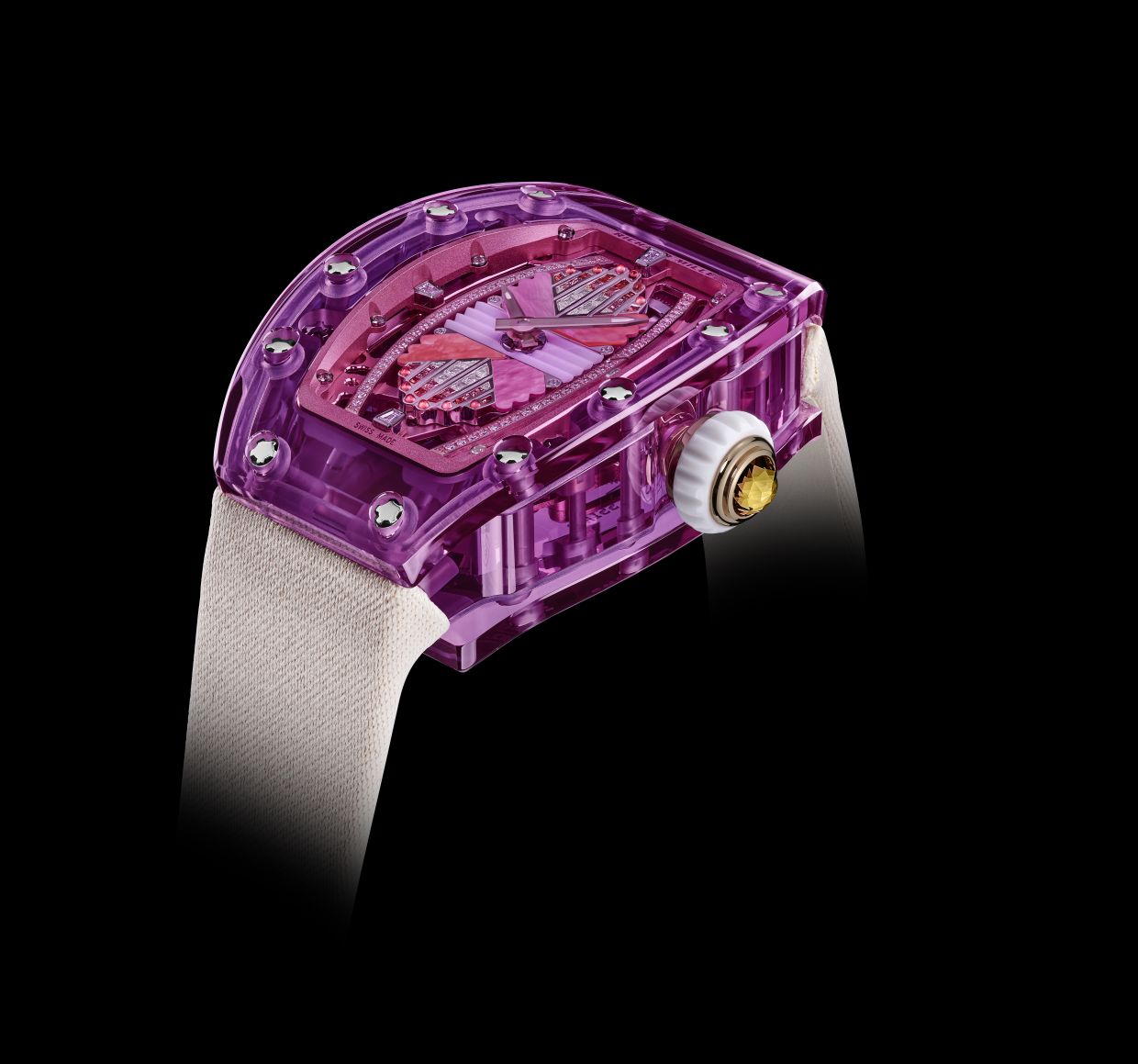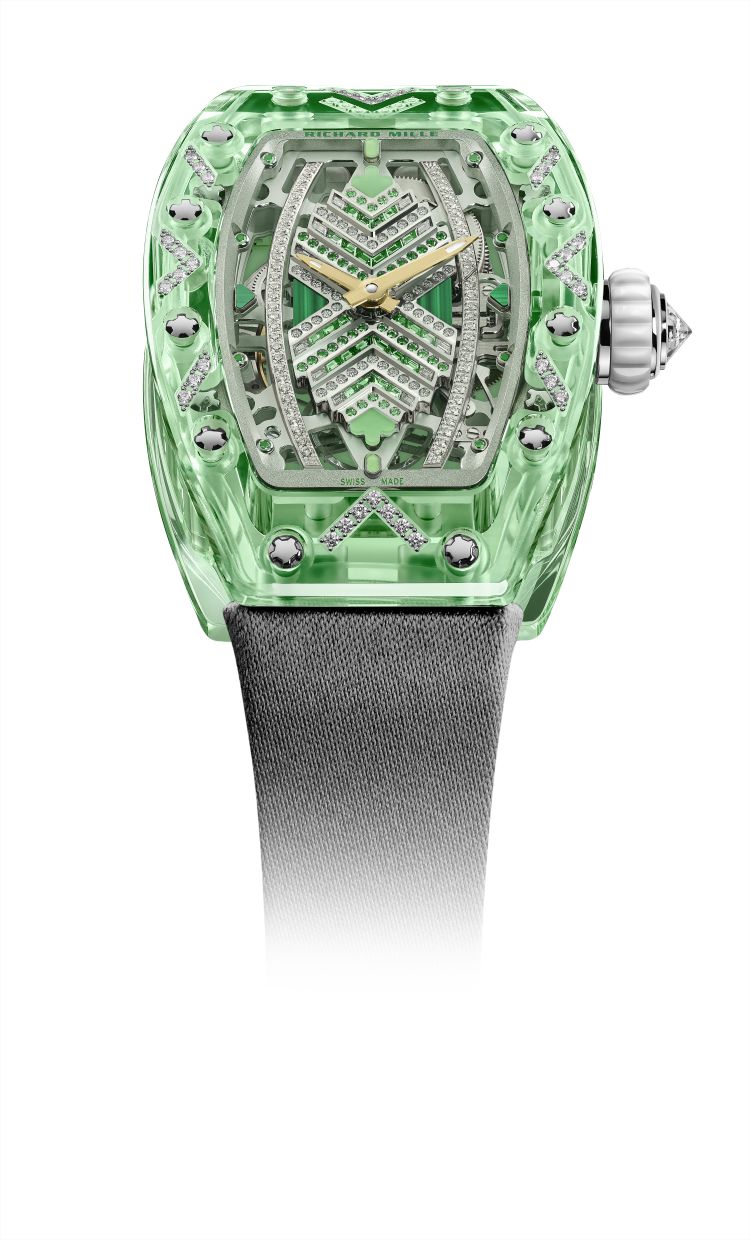Side view of the RM 07-02 Automatic Sapphire in the brand new colour lilac. photos: Richard Mille
Sapphire is now one of the most in-demand materials in watchmaking, but a decade ago, Swiss luxury watch brand Richard Mille was alone in grasping its true potential for use on entire watch cases.
Renowned for its exceptional hardness and scratch resistance, sapphire offers a level of durability unmatched by traditional materials.
Sapphire, including coloured sapphire, is unique in watchmaking, and the sapphire tonneau case is the most challenging for Richard Mille to produce.
By pioneering the use of sapphire in watch cases, Richard Mille redefined luxury watchmaking. This bold move, driven by innovation and a relentless pursuit of perfection, elevated the brand to iconic status.
The brand invested significant resources in researching and developing new techniques that would uplift its most exclusive calibres in unprecedented ways.
The alchemy of coloured sapphire
When Richard Mille unveiled the RM 056 Tourbillon Split-Seconds Chronograph Sapphire in 2012, it blazed a new trail in watchmaking.
Always ahead of trends, the brand very quickly started to use synthetic sapphire for parts of its movements, such as the baseplate, winding barrel bridge, tourbillon bridge and, a few years later, the central bridge in its RM 56-01 and RM 56-02 models.
After unveiling its first sapphire in 2012, Richard Mille delved into the realm of coloured sapphire, a significantly more complex endeavour.
To achieve these vibrant hues, metal oxides are meticulously introduced into the sapphire’s crystalline structure. This delicate process is highly sensitive to temperature and growth rate.
If these parameters are not precisely controlled, the diffusion of oxides can lead to uneven colour distribution or undesirable shades, or even bubble formation within the material.
Replicating consistent colour across different batches presents an additional challenge, demanding meticulous attention to detail and advanced manufacturing techniques.
Every block of sapphire produced represents a triumph, and improvements in crystal growth techniques continue to enhance the brand’s ability to produce high quality coloured sapphires consistently.
Focusing on the beauty of the coloured sapphire, Richard Mille has since introduced various coloured sapphires, from blue, green, orange to pink – which require a much more complex manufacturing process than transparent sapphire, as metal oxides must be meticulously incorporated into the crystalline structure.
A dazzling fusion of diamonds and sapphires In 2015, the brand unveiled its first coloured sapphire creations with the RM 07-02 Automatic Sapphire. These sapphire cases, sometimes set with precious stones, were a world first in watchmaking and perfectly illustrate Richard Mille’s relentless quest to push back boundaries, innovate constantly, and reinvent the aesthetics of modern watchmaking.
This timepiece not only showcased the brand’s mastery of coloured sapphire but also its ability to set diamonds on this incredibly challenging material.
As the second hardest natural material, sapphire possesses extraordinary properties. Its crystalline structure, composed of aluminum oxide, provides exceptional hardness and transparency. By leveraging advanced machining techniques, Richard Mille crafts intricate cases and movement components from solid blocks of sapphire, showcasing the brand’s technical prowess.
The main benefits of sapphire are its transparency and its radiance, which highlights every detail of the brand’s calibres while subtly capturing the light with cases machined entirely from this material.
This timeless, crystalline setting deserved the full attention of engineers and design studios.
It is simultaneously functional, aesthetic and sensory. Its chemical composition gives it an exceptional score of 9 on the Mohs scale of mineral hardness, just behind diamond, which tops the list. Its outstanding properties make it impact- and scratch-resistant, while its soft, tactile surface gives it a warm and comfortable feel on the wrist.
This unique material, the product of precise expertise, embodies both preciousness and innovation.
As in the optical and electronics sectors, the watchmaking industry uses synthetic sapphire, which has exactly the same chemical composition, physical properties and crystalline structure as its natural counterpart, but with the added advantage that it can be produced in blocks large enough for creating Richard Mille cases. A sapphire block weighing several dozen kilos is needed to make the three parts of a single curved Richard Mille watch case.
Machining the impossible
Creating a Richard Mille watch case from sapphire is a complex and time-consuming process. The brand works with its Swiss partner, Stettler AG to utilise the Kyropoulos method to produce sapphire. The process involves heating aluminium oxide to between 2,000 and 2,050°C in a controlled atmosphere; with a small sapphire crystal acting as a seed, encouraging the synthetic crystal to grow slowly around it, in a process that can take several weeks.
The constraints inherent to the use of synthetic sapphire at Richard Mille are unprecedented. Firstly, the complex, curved shapes of its cases have meant that new, particularly demanding machining and finishing processes have had to be introduced. The material’s hardness of 2,000 Vickers and its extreme rigidity during cutting and assembly impose tolerances of just a few microns.
Each case undergoes over 1,000 hours of meticulous milling and polishing, requiring specialised tools and highly skilled artisans.
The result is a stunningly precise and durable case that exudes luxury and innovation. Indeed, the coloured sapphire collection from Richard Mille elevates the aesthetics of modern watchmaking, bringing together the world of haute horology and the colourful facets of haute fashion.
Introducing RM 07-02 Automatic Sapphire
The new RM 07-02 Automatic Sapphire collection highlights the crystalline elegance of coloured sapphire and combines the attractions of a clean design with the mechanical complexity of fine watchmaking.
As Richard Mille connoisseurs are fascinated by the brand’s signature watchmaking techniques, the new RM 07-02 Automatic Sapphire timepieces remain faithful to the first iteration, whose movement can be admired from every angle through a coloured sapphire prism.
It was back in 2015 that Richard Mille boldly chose to design watches with cases made entirely of coloured sapphire. Today, the RM 07-02 Automatic Sapphire collection has been enriched with four new versions – including one in lilac, a brand-new shade – and new interpretations of the gem-set dial.
At the heart of this crystalline cocoon is an intriguing and attractive dial that draws the eye with perfectly symmetrical geometric shapes and refined aesthetics. This central graphic design is a testament to the art of the master gem-setter.
The stones adorning this watch catch the light to enhance every facet of the sapphire case, decorating the dial, bezel and flange. A cabochon also embellishes. Hence, precious stones including dazzling diamonds, hypnotic blue sapphires and vibrant yellow sapphires, are combined with ornamental stones such as orange spessartite, white agate or opal, and various shades of green tsavorite, chrysoprase and malachite.
Behind the sumptuous visual harmony of this piece lies great ingenuity. Protected by its sapphire case, the CRMA5 in-house skeletonised automatic movement, displaying the hours and minutes, is wound by a variable-geometry rotor making it possible to configure the winding of the movement to the activity of the wearer by adjusting two small weights.
This compact calibre has a power reserve of approximately 50 hours. The baseplate and bridges – crafted from either red or white gold depending on the version – are microblasted and chamfered by hand.
The red gold oscillating weight is set with diamonds for an even more precious result. The combination of these myriad details and the finishes, which have been pushed to their extreme, are distinctive elements that further enhance this model.
The use of sapphire at Richard Mille involves major constraints and unique expertise. The brand’s iconic tonneau-shaped case is especially difficult to craft because of its curved lines, which render it particularly ergonomic and comfortable to wear.
However, working with these curves demands additional time at every stage of the creative process, from pre-production to production itself and finishing.
Creating a case of this quality requires over 1,000 hours of machining, of which 430 hours devoted to preforming the case parts and 350 hours reserved for polishing the entire case. The front and rear bezels also receive an anti-reflective coating to guarantee optimal visual properties.
Producing coloured sapphires involves a process that is even more complex than for transparent sapphire: these stones are created by carefully incorporating metal oxides into the material’s crystalline lattice. However, a coloured crystal is more sensitive to the heating and growth process than its colourless counterpart. Developing a new shade like lilac therefore involves a multitude of trials before the exact shade can be approved.
Setting gems into this particular material is a true feat of engineering, as a laser is required to perform the mitraillage, that is drilling holes for the stones. This must be accurate to the nearest micron. Prongs in hand-polished gold, made separately, are then inserted, creating the multiple settings that hold a graceful row of diamonds.
This new collection is the result of an uncompromising quest to combine refinement with technical skill. The RM 07-02 Automatic Sapphire is limited to seven timepieces for each of the four versions: gem-set pink sapphire, lilac sapphire, green sapphire and gem-set green sapphire.












